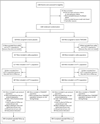Trimethoprim-Sulfamethoxazole versus Placebo for Uncomplicated Skin Abscess
- PMID: 26962903
- PMCID: PMC4851110
- DOI: 10.1056/NEJMoa1507476
Trimethoprim-Sulfamethoxazole versus Placebo for Uncomplicated Skin Abscess
Abstract
Background: U.S. emergency department visits for cutaneous abscess have increased with the emergence of methicillin-resistant Staphylococcus aureus (MRSA). The role of antibiotics for patients with a drained abscess is unclear.
Methods: We conducted a randomized trial at five U.S. emergency departments to determine whether trimethoprim-sulfamethoxazole (at doses of 320 mg and 1600 mg, respectively, twice daily, for 7 days) would be superior to placebo in outpatients older than 12 years of age who had an uncomplicated abscess that was being treated with drainage. The primary outcome was clinical cure of the abscess, assessed 7 to 14 days after the end of the treatment period.
Results: The median age of the participants was 35 years (range, 14 to 73); 45.3% of the participants had wound cultures that were positive for MRSA. In the modified intention-to-treat population, clinical cure of the abscess occurred in 507 of 630 participants (80.5%) in the trimethoprim-sulfamethoxazole group versus 454 of 617 participants (73.6%) in the placebo group (difference, 6.9 percentage points; 95% confidence interval [CI], 2.1 to 11.7; P=0.005). In the per-protocol population, clinical cure occurred in 487 of 524 participants (92.9%) in the trimethoprim-sulfamethoxazole group versus 457 of 533 participants (85.7%) in the placebo group (difference, 7.2 percentage points; 95% CI, 3.2 to 11.2; P<0.001). Trimethoprim-sulfamethoxazole was superior to placebo with respect to most secondary outcomes in the per-protocol population, resulting in lower rates of subsequent surgical drainage procedures (3.4% vs. 8.6%; difference, -5.2 percentage points; 95% CI, -8.2 to -2.2), skin infections at new sites (3.1% vs. 10.3%; difference, -7.2 percentage points; 95% CI, -10.4 to -4.1), and infections in household members (1.7% vs. 4.1%; difference, -2.4 percentage points; 95% CI, -4.6 to -0.2) 7 to 14 days after the treatment period. Trimethoprim-sulfamethoxazole was associated with slightly more gastrointestinal side effects (mostly mild) than placebo. At 7 to 14 days after the treatment period, invasive infections had developed in 2 of 524 participants (0.4%) in the trimethoprim-sulfamethoxazole group and in 2 of 533 participants (0.4%) in the placebo group; at 42 to 56 days after the treatment period, an invasive infection had developed in 1 participant (0.2%) in the trimethoprim-sulfamethoxazole group.
Conclusions: In settings in which MRSA was prevalent, trimethoprim-sulfamethoxazole treatment resulted in a higher cure rate among patients with a drained cutaneous abscess than placebo. (Funded by the National Institute of Allergy and Infectious Diseases; ClinicalTrials.gov number, NCT00729937.).
Figures

Comment in
-
Trimethoprim-Sulfamethoxazole for Uncomplicated Skin Abscess.N Engl J Med. 2016 Jul 21;375(3):285-6. doi: 10.1056/NEJMc1605392. N Engl J Med. 2016. PMID: 27468069 No abstract available.
-
Trimethoprim-Sulfamethoxazole for Uncomplicated Skin Abscess.N Engl J Med. 2016 Jul 21;375(3):284. doi: 10.1056/NEJMc1605392. N Engl J Med. 2016. PMID: 27468070 No abstract available.
-
Trimethoprim-Sulfamethoxazole for Uncomplicated Skin Abscess.N Engl J Med. 2016 Jul 21;375(3):284-5. doi: 10.1056/NEJMc1605392. N Engl J Med. 2016. PMID: 27468071 No abstract available.
-
Trimethoprim-Sulfamethoxazole for Uncomplicated Skin Abscess.N Engl J Med. 2016 Jul 21;375(3):285. doi: 10.1056/NEJMc1605392. N Engl J Med. 2016. PMID: 27468072 No abstract available.
-
Abscess drainage with and without antibiotics.J Pediatr. 2016 Sep;176:221-4. doi: 10.1016/j.jpeds.2016.06.073. J Pediatr. 2016. PMID: 27568257 No abstract available.
-
Antibiotics Should Not Be Routinely Prescribed After Incision and Drainage of Uncomplicated Abscesses.Ann Emerg Med. 2019 Apr;73(4):377-378. doi: 10.1016/j.annemergmed.2018.04.026. Ann Emerg Med. 2019. PMID: 30902165 Free PMC article. No abstract available.
References
-
- Pallin DJ, Egan DJ, Pelletier AJ, Espinola JA, Hooper DC, Camargo CA., Jr Increased US emergency department visits for skin and soft tissue infections, and changes in antibiotic choices, during the emergence of community-associated methicillin-resistant Staphylococcus aureus. Ann Emerg Med. 2008;51:291–298. - PubMed
-
- Qualls ML, Mooney MM, Camargo CA, Jr, Zucconi T, Hooper DC, Pallin DJ. Emergency department visit rates for abscess versus other skin infections during the emergence of community-associated methicillin-resistant Staphylococcus aureus, 1997–2007. Clin Infect Dis. 2012;55:103–105. - PubMed
-
- Moran GJ, Krishnadasan A, Gorwitz RJ, et al. Methicillin-resistant S. aureus infections among patients in the emergency department. N Engl J Med. 2006;355:666–674. - PubMed
-
- Talan DA, Krishnadasan A, Gorwitz RJ, et al. Comparison of Staphylococcus aureus from skin and soft-tissue infections in US emergency department patients, 2004 and 2008. Clin Infect Dis. 2011;53:144–149. - PubMed
-
- Singer AJ, Talan DA. Management of skin abscesses in the era of methicillin-resistant Staphylococcus aureus. N Engl J Med. 2014;370:1039–1047. - PubMed
Publication types
MeSH terms
Substances
Associated data
Grants and funding
LinkOut - more resources
Full Text Sources
Other Literature Sources
Medical
